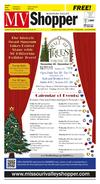041415_YKMV_A3.pdf
shop online at www.missourivalleyshopper.com
April 14, 2015 • Page 3
Replacement Heifer Post
Breeding Management
Impacts Pregnancy Rates
BROOKINGS, S.D. - Replacement heifer’s breeding season
is quickly approaching and strategies to get them ready vary
by operation. However, as Julie Walker, SDSU Extension Beef
Specialist SDSU Associate Professor explained, every cattle
producer’s goal is the same.
“Ultimately, it’s about getting the heifers bred
and preferably early in the breeding season,” Walker
said. Following breeding, Walker said research shows
increased conception rates in heifers depends upon post
breeding management.
“To start with, heifers should be in a body condition score
of 5 or 6 and range between 55 to 65 percent of their mature
weight,” she said. Research conducted at South Dakota
State University provides some insight on the importance
of post breeding management, especially following AI,
explained George Perry, SDSU Extension Beef Reproductive
Management Specialist SDSU Professor. “Previous research
indicated that moving drylot-developed heifers to spring
forage immediately after AI adversely affected average daily
gain (ADG) and AI conception rates,” Perry said. However,
he added that the research showed that after 27 days of
grazing, there was no difference in ADG between heifers
developed in a drylot and heifers developed on forage.
The research, conducted at the Antelope Research Station,
reported that when heifers were moved from drylot to range,
they lost weight - on average 3.5 pounds per day - during the
first week. Whereas range-developed heifers gained weight -
about 2 pounds per day over the same period of time.
“Heifer’s grazing skills and dietary habits are acquired
early in life and this learning is important to develop the
motor skills necessary to harvest and ingest forage,” Walker
said. Based on this, Walker recommended cattle producers
allow animals to increase their consumption of grazed
forage to meet nutrient needs. Perry referenced two studies
conducted at SDSU to determine the impact of adaptation
to grazing on weight change and activity when heifers were
moved to spring forage
(Experiment 1), and whether supplementing heifers when
moved to pasture following AI improved pregnancy success
(Experiment 2). The findings Experiment 1 was
conducted to investigate if heifer development management
could impact grazing behavior. Sixty-nine drylot developed
heifers were randomly allotted to one of two treatments:
1) heifers remained in the drylot, or 2) heifers were moved
to graze spring forage during 42 days. Daily activity was
measured by steps per day. “Heifers that were grazing spring
forage took more steps per day compared to heifers in the
drylot,” Perry said. “However, after they were moved to
spring pasture, heifers that remained in the drylot increased
activity compared to those with previous experience grazing
spring forage
(Figure 1). Walker added that this is significant because
energy requirements increase with activity.
In the second experiment, 301 drylot-developed heifers
were synchronized with the 7-day Controlled Internal Drug
Releasing device (CIDR) protocol. Heifers were either moved
to pasture at AI, or moved to pasture and supplemented
with 5 pounds per head per day of dried distillers grain
(DDGS). Supplementation increased pregnancy success
compared to non-supplemented heifers by 76 percent and 61
percent, respectively. “Thus, post breeding management can
affect performance and activity,” Walker said. Management
options that provide an adaption period for heifers prior
to the breeding season or supplementation when heifers
are moved to pasture can allow for increased reproductive
efficiency.
?iGrow
(Figure 1)
Spring Turn-Out Dates: What Are Your Options?
BROOKINGS, S.D. Every year at green up,
grass managers must make
decisions about when and
where to begin grazing.
Considerations include
hay reserves, the cost of
purchasing additional feed
and the impact of early
grazing on pasture grasses,
explained said Pat Johnson,
SDSU Professor of Range
Science. Before a decision
can be made, there is often
a long list of questions
that need to be answered
including; How long should
they continue to feed stored
forages, to delay the impact
of grazing on pastures? How
early can cattle be turned
out to relieve the cost of
feeding? Which pastures
should be grazed first? “The
answer to these questions
is - It depends,” Johnson
said. “Cattle producers
may have several options,
depending on their pasture
resources, their stored feed
resources and their ability to
be flexible with their grazing
options.”
pasture grasses with time
to shift from dependency
on reserves to utilizing
photosynthesis for energy. If
grazing is initiated too early,
production for the balance
of the growing season can be
reduced.
Graze tame grass
pastures earliest: Access
to pastures planted with
introduced cool-season
grasses, such as crested
wheatgrass and smooth
brome, provides early
season flexibility and
avoids early grazing on
native pastures which may
compromise production
later in the season.
These pastures are
typically ready to be grazed
two or more weeks before
Bar
way
Busch & Busch
Light
Saturday, April 25 -- 11 a.m.
LOCATED: 30174 438th Avenue, Utica, SD
from Yankton, SD, 7 miles north on Highway 81 to 302nd Street then
2 miles west to 438th Avenue then 1/8 mile north on 438th Avenue
OR from Utica, SD, 2 miles east to 437th Avenue, then 1 mile north
and 1 mile east and north to 438th Avenue then 1/8 mile north
(south edge of State Lake). Roads will be marked.
Lord Calvert
1.75 L
30pks
16.35
14.99
$
$
Ancient Age
McCormicks
Vodka 1.75 L
1.75 L
18.99
12.99
$
$
HARDWOOD
PELLET
GRILLS
$599
2015 Toro SWX5050
Zero Turn w/Steering
Wheel, 22 H.P.,
50” Fabricated Deck
$4,699
Lee Wittmeier, Tyndall, SD
2015 Scag Liberty Z
EASY AS A PUSH OF A BUTTON SET IT & FORGET IT!
Mother’s Day Special!
$50 OFF
52” Cutting Deck,
24 H.P. Kohler
$4,500
5 miles West of Tyndall on Hwy. 50 Corner of Hwys. 50 and 37
www.schuurmansfarmsupply.com
Ph. (605) 589-3909 or Cell (605)464-1113
Two Locations
to Serve You!
3211 E. Hwy. 50 • Yankton, SD
605-665-4540-• 800-526-8095
Keith & Lorna Cameron, Owners
Not Responsible for Accidents
Price Effective
April 14th - 20th
GREEN MOUNTAIN
GRILLS
A complete listing will appear next week
www.petersonauctioneers.com
605-665-7865
Hours
Monday-Friday
8:30-6:00
Saturday
9:00-4:30
NEW
WHEN IT COMES TO GRILLING,
TASTE RULES...
NEW
A line of ATV, boat, guns, lawn, garden, shop and
household items will be sold. This is a great selection
of good quality very clean well cared for items.
This auction has something for everyone.
TERMS: Cash
FREE
Customer
Parking
Schuurmans Farm Supply
rip!
The
AUCTION
Limited Supply
Comfortable Shoes,
Comfortable Price
Boston Shoes to Boots
312 W. 3rd, Yankton • 665-9092
109 W. 3rd St. in Downtown Yankton
1019 Broadway, Yankton, SD 57078
605-665-3751 or 1-800-665-5455
or call Joe Schieffer, owner, at 605-661-1799
www.yanktonmotorcompany.com
Offering NEW & USED
LARGE & SMALL
Ult
imate Road T
Something for Everyone!
www.bargainbuyway.com
Guidebooks
available Locally!
or call 402.893.2880
? SPRING,
Page 5
www.yanktonrexall.com
YANKTON MOTOR CO.
gain Buy
from the weather station at
Oral indicates the average
date at which 1200 GDD
accumulate is May 28. For
Nisland, average date for
1200 GDD is June 1. Recently,
1200 GDD accumulated as
about 1200 GDD,” Johnson
said.
Johnson explained that
the calendar date when
these growing conditions
occur varies considerably
from one location to another
and from year to year.
For example, climate data
Liquor Specials
See us today
for all your
automotive needs
APRIL 24, 25, 26, 2015
250+ Miles
30+ Towns
200+ Vendors
leaf stage provides a general
“rule-of-thumb” about plant
development.
The date that grasses
reach the three-leaf stage
varies considerably, so
examining the important
plants in your own pasture is
recommended.
One way to come up with
a date to begin examining
your grasses is to use
“growing degree days” (GDD
base 32 degrees Fahrenheit
after March 1).
“For introduced grasses,
the three-leaf stage generally
requires accumulation of
about 500 GDD; many native
cool-season grasses require
WE BUY, SELL &
TRADE QUALITY
USED VEHICLES!
Options
Depending on a cattle
producer’s situation,
Johnson provides a list of
turnout options to consider.
Continue feeding
livestock a few weeks
longer: If a producer has
the feed reserves available,
feeding livestock a little later
into spring provides the
native pastures.
Flash grazing winter
pastures: A recent study
demonstrated that native
winter pastures could
be grazed in mid-May at
about 25 percent relative
use without a decrease in
stockpiled winter forage.
Exceeding 25 percent use or
extending grazing into midJune, however, could reduce
forage in those pastures that
you will need next winter.
Wait to graze native
pastures until grasses are
“ready.” Research suggests
that grass plants are most
vulnerable to grazing before
they have formed three new
leaves. Knowing how many
growing degree days are
required to reach the three-
Locally Owned and Operated Since 1972
Or
visit
us
at:
745 E. Hwy 46 • Wagner, SD
605-384-3681 • 800-693-1990
w w w. m a r k s i n c . c o m



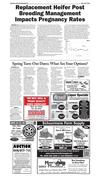



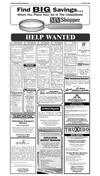

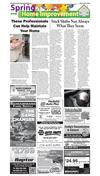
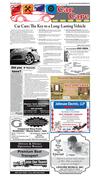


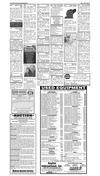







 Previous Page
Previous Page



